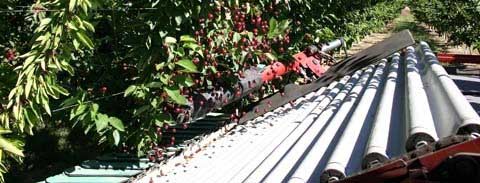
The Pacific Northwest sweet cherry industry likely will face significant, periodic labor shortages this season. The consequences of an insufficient harvest labor force affect the entire industry and can impact grower returns via crop losses (from not being able to harvest the crop at all) and/or reduced fruit quality (from not being able to harvest the crop at optimal quality).
Fruit quality declines as growers are compelled to hire picking crews prematurely and preemptively in order to secure a labor force. When picking crews cannot harvest fruit in a timely manner, fruit quality also declines, as fruit may be suboptimal and overripe. Fruit quality overall may suffer too if the industry is forced to integrate inexperienced crews in a short labor year. The costs of harvest labor will increase too as growers are forced to compete for labor by offering better pay and/or other incentives. Growers most susceptible to any shortages of labor are those with midseason varieties on vigorous rootstocks and at low tree densities. Clearly, these concerns underpin the ongoing transition to higher efficiency sweet cherry orchard systems in the Northwest.
At Washington State University in Prosser, we are developing novel orchard systems for improved labor efficiency. In addition, in cooperation with the U.S. Department of Agriculture’s Agricultural Research Service, and with funding from the Washington Tree Fruit Research Commission and WSU’s IMPACT Center, we are investigating the potential of a novel mechanical harvest system for fresh-market-quality stem-free cherries. In preliminary testing, this system has shown potential to improve labor efficiency about 50-fold with negligible impacts on fruit quality. Our research continues to address the key components of this labor-saving technology:
• Sweet cherry abscission physiology
• The efficiency of the mechanical harvest system
• Effects of the mechanical harvester on fruit quality
• Effects of the mechanical harvester on fruit storability and shelf-life
• Consumers’ perceptions of stem-free sweet cherries.
The prototype harvester
The prototype harvester was developed by Dr. Donald Peterson of the USDA-ARS in Kearneysville, West Virginia. It comprises two separate mirror-image units that connect around the tree’s trunk. Unlike previous mechanical harvesters, this system does not clamp and shake the trunk to gather fruit. Rather, the cherries are removed by a rapid and precise jolt of selected fruiting limbs. When trees are trained to angled fruiting walls (i.e., single canopy planes), fruit drop directly onto the padded catching surface.
Our previous testing showed that the retention force between the fruit stem (pedicel) and the cherry (i.e., the energy required to remove the fruit) should be about 300 to 400 grams for the harvest to be complete. The amount of energy required to separate fruit from stems is related to the development of an abscission zone between the fruit and the stem. One of the first avenues of research was therefore to investigate abscission physiology and pedicel-fruit retention force in current cultivars, to determine their potential for mechanized harvest.
Abscission
A sweet cherry has two zones of abscission, at the pedicel-spur junction (where fruit are normally removed), and between the pedicel and fruit. Previous research at Michigan State University showed that ethephon, an ethylene-releasing bioregulator, can reduce the pedicel-fruit retention force when applied during stage III of fruit development.
From evaluations of cultivars in the Northwest, we have identified three categories, based on their response to application of ethephon: responsive (retention force declines from ethephon application), nonresponsive (ethephon has no, or insufficient impact on retention force), and naturally abscising (retention force naturally declines without treatment). In short, not all cultivars are suitable for mechanical harvest, and some will not require any application of ethephon.
Bing responds well to ethephon treatments. Our timing and rate trials showed that applications must be made at least 10 days before harvest, and rates as low as 1 pint per acre are sufficient to reduce retention force to less than 400 grams (see “Fruit stem separation force”). In contrast, Chelan is largely unresponsive to ethephon, at rates up to 5 pints per acre, and not recommended for mechanical harvest. Chelan pedicel-fruit retention force did not approach 400 grams in any trial—our recorded average was 722 grams, across all treatments. Skeena is a cultivar we recommend for mechanical harvest because it exhibits a natural decline in retention force, without any ethephon. We observed a decline in Skeena pedicel-fruit retention force to around 400 grams at optimum harvest maturity. At that stage, we recorded complete fruit removal by mechanical harvest. This abscission characteristic (i.e., uniform and natural reduction in retention force) is ideal for mechanized harvest because, even though ethephon effectively reduces retention force of certain cultivars, its application has also been associated with negative effects on fruit quality.
Fruit quality and storability
Our studies have evaluated also the impact of ethephon and harvest system (hand vs. machine) on fruit quality at harvest and throughout cold storage. We have found that, irrespective of variety (and the extent to which retention force is affected), ethephon advances fruit maturity by hastening coloration and increasing soluble solids. Fruit firmness is often, but not consistently, reduced by ethephon. In addition, our storage trials showed that weight of fruit treated with ethephon declined similarly to those which were untreated. We found no impact of ethephon, the presence or absence of the stem, or harvest system (i.e., hand versus machine) on postharvest dehydration. In another study, we recorded no differences in respiration rate of fruit harvested by hand compared to those harvested mechanically. In addition, the onset of postharvest rots occurred after a similar duration in storage for both machine-harvested and hand-harvested fruit samples—another indication that the mechanically harvested, stem-free sweet cherries may be stored as long as traditional fruit with stems.
Further reading
Peterson, D., M.D. Whiting, and S. Wolford. 2003. “Fresh market quality sweet cherry harvester.” Applied Engineering in Agriculture. 19: 539-543.
Warner, Geraldine, “Researcher fine-tunes cherry harvester,” Good Fruit Grower, June 2002.
Whiting, Dr. Matthew, “The next generation sweet cherry orchard,” Good Fruit Grower, May 15, 2006.

Leave A Comment